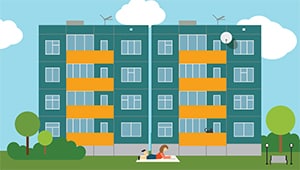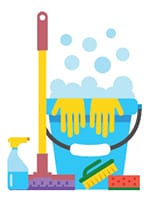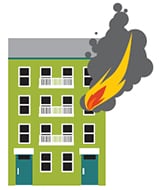Going Smokefree Matters: Multiunit Housing
- About 80 million (1 in 4) people in the US live in multiunit housing, such as apartments, including about 7 million living in government-subsidized housing.3
Multiunit Housing

What is government-subsidized housing?
When the government helps people pay their rent. Public housing is one type of subsidized housing.
Smokefree

Approximately 1 in 3 multiunit housing residents are covered by smokefree building policies.4
About 8 in 10 multiunit housing residents have chosen to make their own homes smokefree.4
A majority of multiunit housing residents want smoke-free building policies.4
Did You Know?
Secondhand smoke can travel into an apartment from other apartments and common areas through doorways, cracks in walls, electrical lines, ventilation systems and plumbing.1,
Opening windows and using fans does not completely remove secondhand smoke.1,
Heating, air conditioning and ventilation systems cannot eliminate exposure to secondhand smoke. In fact, these systems can distribute secondhand smoke throughout a building.1,

What is secondhand smoke?
It is the combination of smoke from the burning end of a cigarette and the smoke breathed out by a smoker.
When a person smokes near you, you can be exposed to secondhand smoke.
The Surgeon General concluded:
There is no safe level of secondhand smoke exposure.1
Cleaning the air and ventilating buildings cannot get rid of
secondhand smoke.1
Secondhand smoke causes disease and early death in children and in adults who do not smoke.1
In the United States:
Approximately 58 million (1 in 4) nonsmokers are exposed to secondhand smoke.5
About 2 in 5 children (including 7 in 10 black children) are exposed to secondhand smoke.2
Smokefree rules or policies:
- Improve Air Quality
- Improve Health
- Reduce Secondhand Smoke Exposure
- Receive Public Support
- Reduce Smoking in Youth,Young Adults, and Adults
Smokefree policies in multiunit housing can improve health and save money.
If all public housing in the United States was made smokefree, it would save $153 million each year, including

$43 million in costs from cleaning apartments where people have smoked

and $16 million in costs from fires caused by smoking.8
Savings would be even greater if all multiunit housing across the country went smokefree.
To learn more about your state’s smokefree policies, go to: CDC’s STATE System.
To learn more about the health consequences of smoking and secondhand smoke exposure visit CDC’s Smoking and Tobacco Use.
- U.S. Department of Health and Human Services. The Health Consequences of Involuntary Exposure to Tobacco Smoke: A Report of the Surgeon General—Executive Summary. U.S. Department of Health and Human Services, Centers for Disease Control and Prevention, Coordinating Center for Health Promotion, National Center for Chronic Disease Prevention and Health Promotion,Office on Smoking and Health, 2006.
- Centers for Disease Control and Prevention. Vital signs: disparities in nonsmokers’ exposure to secondhand smoke — United States, 1999–2012. MMWR Morb Mortal Wkly Rep. 2015;64 (04):103-108.
- King BA, Babb SD, Tynan MA, Gerzoff RB. National and state estimates of secondhand smoke infiltration among U.S. multiunit housing residents. Nicotine Tob Res. 2013;15 (7):1316-1321.
- Andrea S. Licht, Brian A. King, Mark J. Travers, Cheryl Rivard, and Andrew J. Hyland. Attitudes, Experiences, and Acceptance of Smoke-Free Policies Among US Multiunit Housing Residents. American Journal of Public Health: October 2012, Vol. 102, No. 10, pp.1868-1871. doi: 10.2105/AJPH.2012.300717.
- Centers for Disease Control. Vital signs: nonsmokers’ exposure to secondhand smoke-United States, 1999–2008. MMWR Morb Mortal Wkly Rep. 2010;59 (35):1141-1146.
- U.S. Department of Health and Human Services. The Health Consequences of Smoking—50 Years of Progress: A Report of the Surgeon General. Atlanta, GA: U.S. Department of Health and Human Services, Centers for Disease Control and Prevention,National Center for Chronic Disease Prevention and Health Promotion, Office on Smoking and Health, 2014.
- King BA, Peck RM, Babb SD. National and state cost savings associated with prohibiting smoking in subsidized and public housing in the United States. Prev Chronic Dis. 2014; 11:40222.
- Farrelly, M. Loomis, B, et. al. Are tobacco control policies effective in reducing young adult smoking? Journal of Adolescent Health 54 (2014) 481-486


